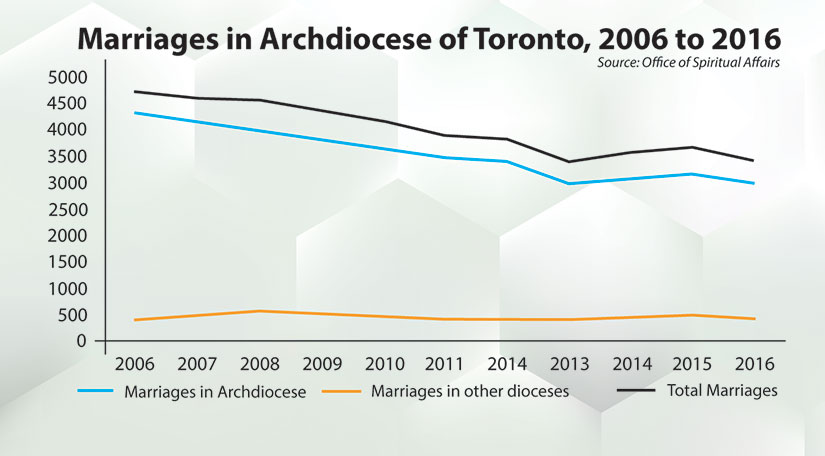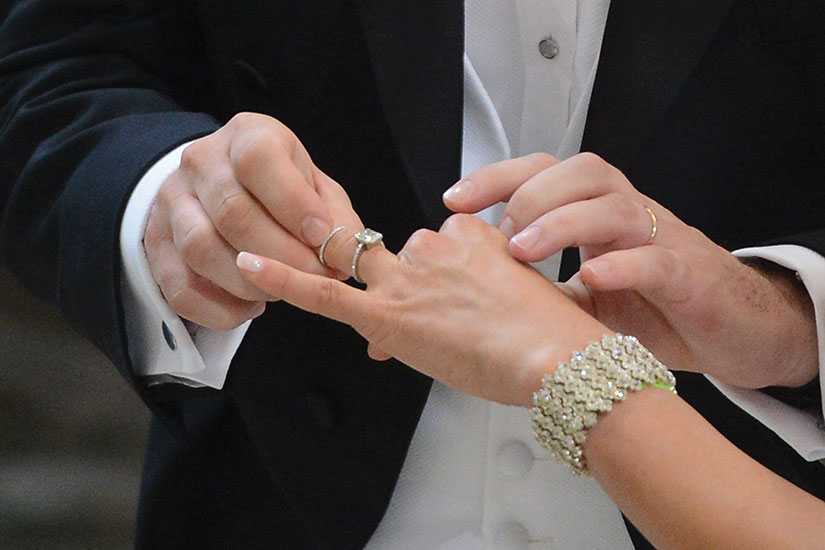So as Megan and Ben Turland walked to St. Peter’s Square in full wedding attire for an appointment with the Pope, they felt all the city’s eyes were on them. It was May 6, 2015 and they were about to join other newlyweds to receive a papal blessing just four days after they had tied the knot in Windsor, Ont.
“It was a like a sea of white,” said Megan, who estimated there were about “30 or 40 couples” waiting to greet the Pope after his weekly general audience. “He goes around and talks to each couple for a minute or two.”
Ben, 30, and Megan, 28, had registered to join the other newlyweds who would meet the Pope and personally offer their marriage to the Church. Ben planned to tell the Pope about their work as missionaries for the Catholic Christian Outreach (CCO) movement in Canada. He wanted to talk about the couple’s testimony of faith and ask Francis to bless their crucifix which had their marriage vows embedded within. But he froze.
“He came up and I just got nervous,” said Ben. “I just said, ‘Oh, we brought you a gift.’ ”
He handed over a small bottle of maple syrup and explained it was a sweet syrup from Canada to use at breakfast. The Pope smiled.
“You can tell that he knew what it was,” said Ben. “Then, he’s like, ‘Oh, it’s like the vegetable in Canada,’ and he said it in a grandfatherly, joking way…. It became this pastoral and personal moment.”
But the meeting was more than just an opportunity to shake the hand of a famous figure. It was the young couple’s testament to the Catholic vocation of marriage and to wedding vows that fewer and fewer Catholic couples are making. One alarming statistic from the Vatican’s statistical yearbook of the Church showed a 71-per-cent decline in Canada’s Catholic marriages from 1975 to 2008, more than double the decline of weddings in general. In the U.S., Catholic marriages decreased about 54 per cent from 1975 to 2010.
Moreover, the Church is also challenged by a wedding reality far different from the classic nuptials of the 1950s and ’60s, with many couples coming to the altar having lived together and perhaps already with children.
 Graphic by Erik Canaria)
Graphic by Erik Canaria)
Pope St. John Paul II began the tradition of greeting and encouraging newlyweds early in his pontificate. Almost four decades ago he recognized that society was on the cusp of a marriage and family crisis. The practice was continued by Pope Benedict XVI and now Francis.
The marriage crisis that alarmed St. John Paul is even more apparent now. In the span of three pontificates, there has been a steep worldwide decline in weddings, including a sharp drop in Catholic weddings.
The Centre for Applied Research in the Apostolate (CARA) at Georgetown University in Washington, D.C., has been tracking the phenomenon with the Unites States Conference of Catholic Bishops. World data they collected from the Vatican’s statistical yearbook and other sources indicate a 33-per-cent decrease in Catholic marriages between 1970 and 2015.
Increasing numbers of young couples are choosing to live together instead of tying the knot. In Canada, overall marriage rates fell about 22 per cent from 1981 to 2008, according to a 2011 Statistics Canada census. In 1961, 90 per cent of Canadian households were headed by married couples. In 2011, that figure had fallen to 67 per cent.
Fr. Amedeo Nardone doesn’t need statistics to confirm the phenomenon is happening in his parish. St. Jane Frances in Toronto will hold about 12 to 15 weddings this summer, said Nardone. But only 14 years ago, the church would host 20 weddings per year. He said it hasn’t been a steep decline, but there has been noticeable change.
“By number but also in kinds and backgrounds,” said Nardone. “Quite often, we see mixed marriages among Catholics and other Christians, non-baptized, different cultures. The majority of them are not attending, they are not churchgoers... There are more couples that come and are already living together in common-law marriage.”
Nardone said although many of these couples are non-churchgoers, they have a desire to continue their relationship with the Church, and that is something to celebrate.
“I am often tough with them,” he said. “This is the law of the diocese, 12 months (engagement), to make them aware of how important is the step they are undertaking, to help them get to know each other, and also to get them back to the Church and they are made aware that they belong to a community.”
Nardone has been a priest for 14 years. He said it is rare today for church weddings to be well-prepared with active participation at the Mass. However, a part of the priest’s role is to journey with couples during their year of preparation, he said.
...
 In the span of the pontificates of the last three popes — John Paul II, Benedict XIV and Francis — a marriage crisis has grown alarmingly. There has been a steep worldwide decline in weddings, and a sharp drop in Catholic weddings. Vatican data indicate a 33-per-cent decrease in Catholic marriages between 1970 and 2015. Many couples are choosing to live together rather than marrying. (CNS photo)
In the span of the pontificates of the last three popes — John Paul II, Benedict XIV and Francis — a marriage crisis has grown alarmingly. There has been a steep worldwide decline in weddings, and a sharp drop in Catholic weddings. Vatican data indicate a 33-per-cent decrease in Catholic marriages between 1970 and 2015. Many couples are choosing to live together rather than marrying. (CNS photo)
Although not all of Ben and Megan’s families are particularly religious, the couple decided early in their engagement that their wedding and marriage would be a testimony of their faith.
“My family doesn’t enter the church very often,” said Ben. “This was probably their first time in maybe 10 years. For them to just have a positive experience (at church), you feel like you’ve been intentional and seized an opportunity to proclaim Christ and show His love to people in a new way.”
The couple chose to get married at St. Anne’s Church in Windsor, closer to Megan’s family rather than Ben’s family in British Columbia. Although St. Anne’s isn’t the couple’s home parish, Megan said she made it a point to invite the parishioners to their wedding Mass.
“It was really important for us to invite as many people as possible, especially to the Mass,” she said. “For me, that was really important because it’s not just two of us. We need prayers and support not just for that day, but we continue to need the prayers and support of our friends, family and community.”
Megan said they wanted to be intentional in all aspects of their ceremony. They were married by Fr. Paul Morris, a good friend and spiritual guide who worked with them in CCO missions. Together with Morris, they prayed and discerned over which readings to choose. They were intentional in the liturgical songs, their lectors and their vows. They also prayed a novena to St. Joseph with friends and family prior to their May 2, 2015 wedding.
“I think, for me, marriage is personal between the two of us, but also communal,” said Megan. “The family is the domestic Church and it’s like the building blocks of the larger Church so it’s important that the people that will be supporting us in our marriage are included.”
However, few people in their marriage prep course shared those sentiments. Maybe 80 or 75 per cent of the couples already lived together, said Megan, and many were not practising Catholics, so the courses were largely geared towards those couples.
Fr. Santo Arrigo said that because St. Patrick’s Catholic Church in downtown Toronto is surrounded by condos in the downtown core, the parish naturally includes many young couples. A majority of them either live together or already have a child together. However, as pastor, he said it is his role to receive these couples with a pastoral welcome.
“The question is if they don’t come to church, how well do you welcome them,” said Arrigo. “It’s not to grill them about why they’re not coming, it’s about seeing this as an opportunity to be that welcoming presence... that St. Patrick’s, or the Church, is not a place that is like an ogre.”
Like the rest of the world, the Archdiocese of Toronto, Canada’s largest diocese, has witnessed a decrease in Catholic weddings — down 28 per cent from 2006 to 2016. Archdiocese spokesperson Neil MacCarthy said many couples today are unfamiliar with the sacramental norms around weddings, and it is the role of the priest and the parish to educate them.
“The church isn’t a facility to rent. It’s a spiritual home, a place we hope will be a part of their life together as husband and wife,” said MacCarthy. “That’s why it’s important for a couple wanting a Catholic marriage to have an active faith life — to pray together, to be active in their parish, to have a relationship with their parish priest, to participate in a solid marriage preparation program.”
Despite the trend away from marriage and, in particular church weddings, Nardone remains optimistic.
“Quite often I meet couples I marry come back and when I see them together with children, I feel refreshed,” said Nardone. “That happens quite often and it makes me happy. It gives you a kind of energy as a priest.”
Renewing vows after 40 years: Read Herman Goodden's column here.


